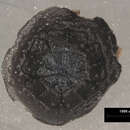Diagnosis
provided by World Register of Marine Species
Holopodidae with entire animal reduced to a convex cap or rounded cone of variable height. First primibrachial (and sometimes also secundibrachial) series forming pentagonal vault closing over adoral surface. Arms reduced, not visible when coiled inward. Upper edge of cup more or less 5-sided, occupied by low and wide articulations for arms, meeting interradially or just separated by very small projections at interradial edge, continued and enlarged inward; in adults, forming thickened interradial structures in the radial cavity. Radial articular facet with straight, crenulate fulcral ridge, narrow and very deep aboral ligament pit; no distinct interarticular ligament fossae, adoral muscle fossae inward sloping. Neural canal of radials superficial or exposed. Arms composed of a proximal and a distal series of brachials; proximal series with 2 primibrachials that may be fused and are axillary, with first 10 secundibrachials forming protective vault over adoral side of cup and coiled distal brachials series. Stout first primibrachial and first secundibrachial meet laterally in flat joint facets with pattern of curved furrows. Adoral surface of first secundibrachial with narrow median ambulacral furrow to more or less inward directed articulation for small succeeding brachial, and side furrow to articulation of first pinnule near proximal, abradial edge of plate. Secundibrachial 2 and succeeding secundibrachials smaIl, corresponding to coiled part of arm.
3. Lack, P. (1986)
The Atlas of Wintering Birds in Britain and Ireland. T. & A. D. Poyser Ltd, Calton
- license
- cc-by-4.0
- copyright
- WoRMS Editorial Board

